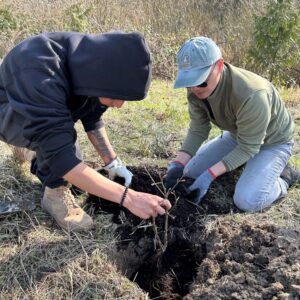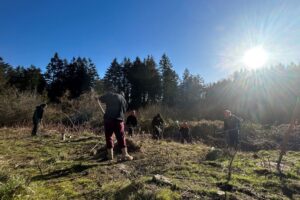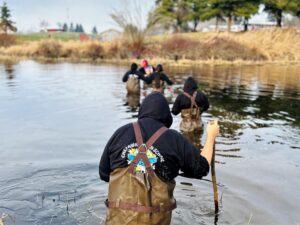A Sense of Place
Students at Chemawa Indian School connect with the Indigenous relationship to the land
Friends of Trees has been partnering with the Chemawa Indian School, a Native American boarding school in Salem, for over eight years on a program designed to provide opportunities for students to build knowledge and skills that could lead to careers in the environmental field.
This year, Chase Huntley joined the team as an Education Specialist working with the Chemawa Program. He developed a syllabus around general conservation ecology and restoration, and how it connects to bigger ideas.
“It’s really important to make things culturally relevant,” Chase says. “Communities have always had a relationship to the land to the water. So I wanted to focus on the place we’re at and how it’s important to Indigenous people.”
The course is a combination of classroom, field study, and hands-on activity. The seven high school students in the class are all from different groups around the country, so much of the local land and its history was new to them. Chase hosted guest speakers to talk about Traditional Ecological Knowledge (TEK) specific to the Kalapuya and other nearby tribes.
“Because these students are at a boarding school, I wanted to make sure we got outside as much as possible,” Chase says. “There’s so many benefits to being outside, including getting to know the land.”

One of Chase’s goals is for the students to shift away from the Western perspective that considers people and nature as separate. From the point of view of Indigenous people, people are intricately involved with nature. “Every plant has a purpose, not just ecologically but also culturally,” he says.
Much of the classroom study considered how Indigenous people have a role in shaping the land. Weekly themes included wildlife, water, restoration, environmental justice, plants, and careers, all with the Indigenous perspective.
Students were able to build a sweat lodge, and make arrows out of willow branches. Some of the hands-on work included blackberry removal and managing other invasive species. They also worked on mulching, planting native plants, and general maintenance.
“I wanted the activities to be student-led and it turns out they really enjoyed blackberry removal, Chase says. “But not just for something to do—we made sure that we understood the why behind what we’re doing.”

Chase is excited about the momentum the program has. His goal for this year was to build a strong foundation and develop partnerships, something he’ll continue doing next school year.
“I want to get more input from the Confederated Tribes of Grand Ronde,” he says. “There are so many resources on the land that we can study. And I want to get off the campus more too, so that we can see even more of the area.”
With more guest speakers and more field trips, students can continue to connect the dots to the big picture and develop a sense of place connected to the larger watershed and indigenous lands in the area. Students will also train as crew leaders for the first time since before the pandemic, providing them with opportunities to participate in more green space and neighborhood planting events in Salem as both volunteers and crew leaders.

